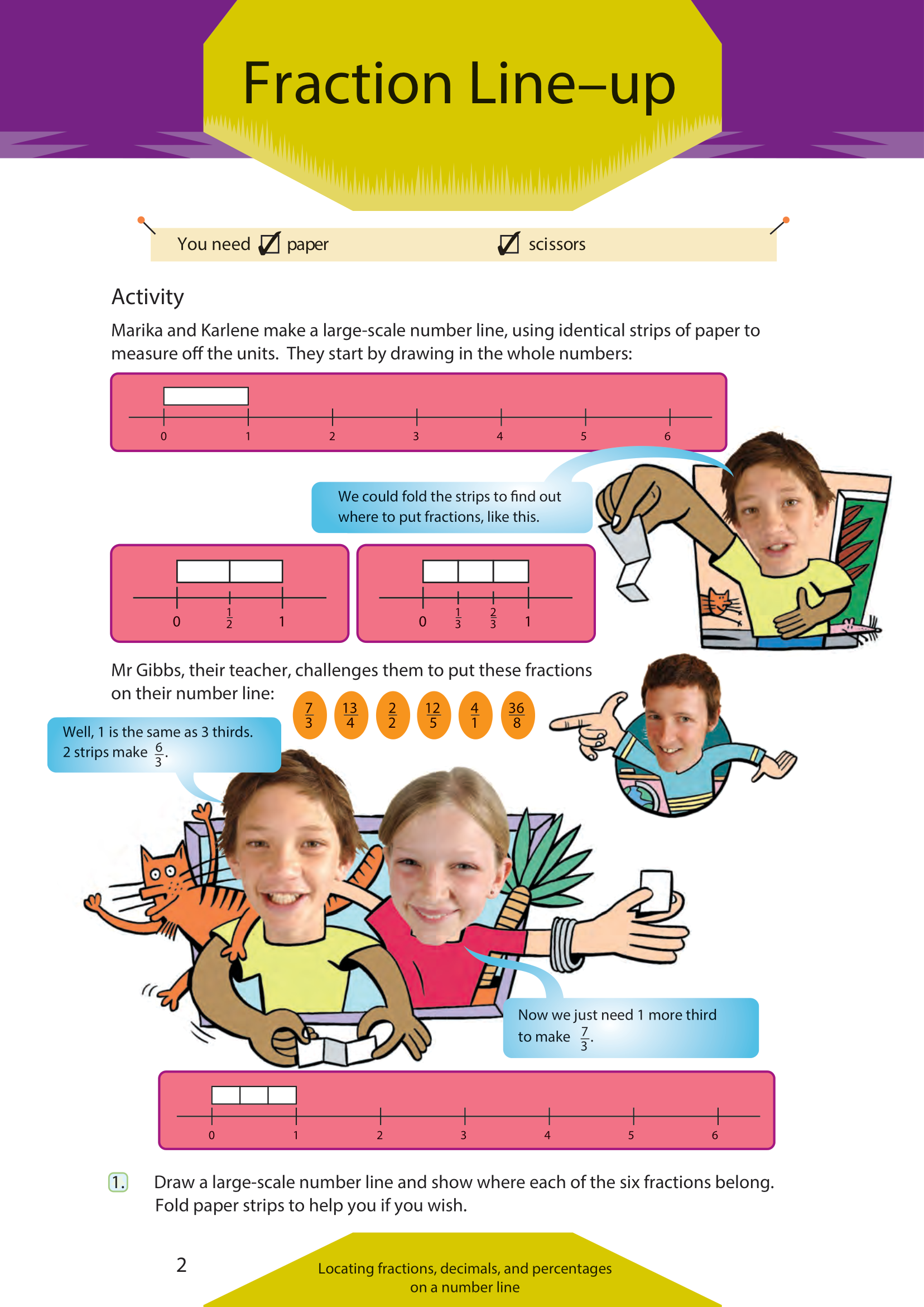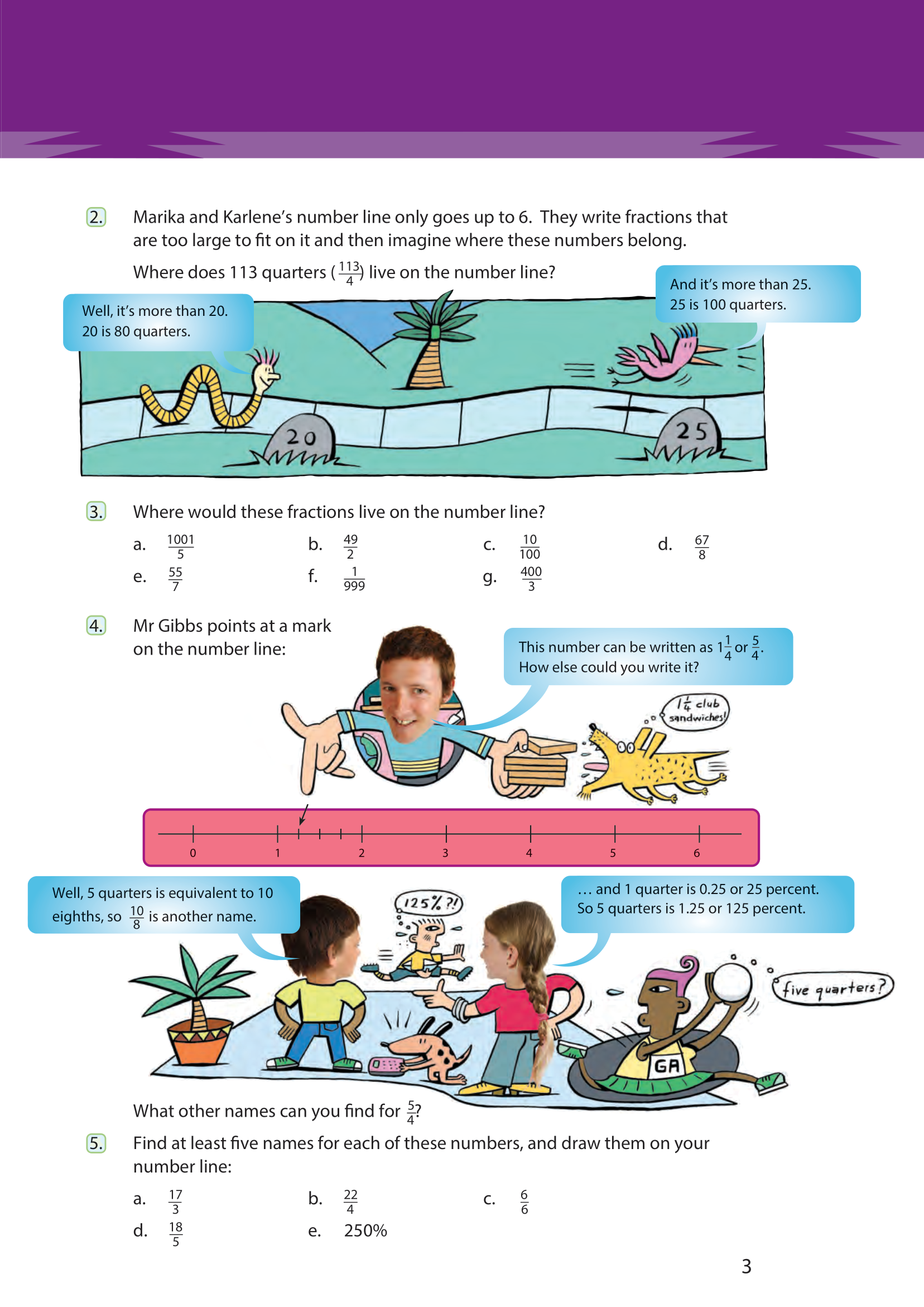This is a level 4 number activity from the Figure It Out series. It relates to Stage 7 of the Number Framework.
Click on the image to enlarge it. Click again to close. Download PDF (726 KB)
order fractions
convert improper fractions to mixed fractions
find equivalent fractions
Number Framework Links
Use this activity to help students consolidate and apply their knowledge of fractions through stages 5, 6, 7, and 8.
FIO, Level 3-4+, Proportional Reasoning, Book One, Fraction Line-up, pages 2-3
Paper, Scissors
Questions 1 and 2 of this activity are best introduced in a guided teaching session. Once the students have completed and understood them, they may be able to work independently.
After reading through the introduction, ask “What would be a good length for our unit strip?” Discuss with your students how many folds will be needed and the lengths that can be measured and marked on the folds. The students may see that choosing a length that matches a common denominator for all seven fractions will make the task easier and aid accuracy. 120 mm is probably the shortest length suitable for folding.
Have the students make separate strips marked in thirds, quarters, fifths, and eighths so that they can choose the appropriate one to locate each of the different fractions in the question 1 challenge.
A feature of question 1 is that the numerators of all the fractions are greater than or equal to the denominator. This is to discourage the common misconception that fractions are always numbers less than 1.
Questions 2 and parts of 3 are designed to encourage students to extend by imaging the number line that they have made. Ask them to visualise the position for the fraction, tell a classmate where it should be, and explain their reasoning. The speech bubbles suggest how such an explanation might be made. Ask the students to be as precise as possible in their descriptions. Then get them to illustrate the location on a small section of the number line.
Your students may never have worked with a number line that doesn’t start at 0, so you may need to explain what is meant by “a small section of number line”. In reality, a number line extends infinitely in both directions (called the number line), so all we ever work with is “a small section” (called a number line). We draw as little as we need to show what we want to show, and if this means that we must image the location of 0 somewhere in the distance, that’s fine.
To answer questions 3 and 5, students need only show the part of the line that includes the whole number immediately above and below where the fraction belongs, as in this example:
Before your students start to answer questions 4 and 5, they should read and understand the conversation that takes place in the speech bubbles. You will need to specifically teach or revise the equivalence relationship that exists between the fraction, decimal, and percentage expressions of a number. In everyday practice, we use the word fraction for numbers expressed in the form 3/4 or 1 1/2. But 0.75 and 1.5, 75% and 150% are also fractions, differing only in their appearance. This means, of course, that 3/4, 0.75, and 75% are all the same point on the number line. You could use
Percentage Strips (Material Master 7–4) and the associated activity in Numeracy Project Book 7: Teaching Fractions, Decimals, and Percentages, page 31, to help teach the relationship between fractions and percentages.
Answers to Activity
1.
2. 113/4 = 28 1/4
3. a. 1001/5 = 200 1/5
b. 49/2 = 24 1/2
c. 10/100 = 1/10
d. 67/8 = 8 3/8
e. 55/7 = 7 6/7
f. 1/999 (very close to zero)
g. 400/3 = 133 1/3
4. There are many other names, including 15/12, 20/16, 25/20.
5.a. There are many names, including 5 2/3, 34/6, 170/30, 51/9, 85/15, 5.67, 567%.
b. There are many names, including 5 2/4, 5 1/2, 5.5, 11/2, 33/6, 550%.
c. There are many names, including 1/1, 2/2, 3/3, 23/23, 100/100, 1, 1.0, 100%.
d. There are many names, including 3 3/5, 36/10, 3.6, 54/15, 3 9/15, 360%.
e. There are many names, including 2 1/2, 5/2, 10/4, 2 3/6, 250/100, 2.5.

